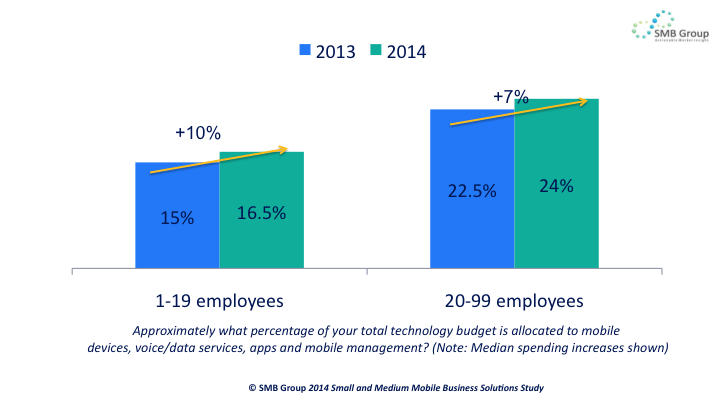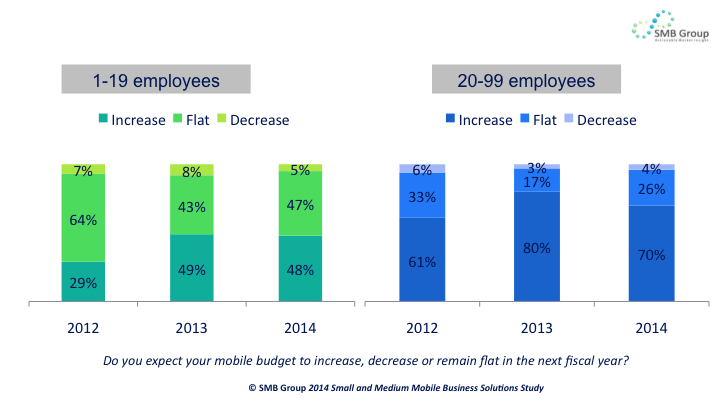Mobile technology is revolutionizing how small businesses get things done. Over the last few years, SMB Group has conducted detailed surveys to quantify the impact of mobile in the small business market. Having recently published our 2014 SMB Mobile Solutions Study, we thought the timing was right to look at some key benchmarks to illuminate just how quickly very small (1-19 employees) and small (20-99 employees) businesses are evolving in the mobile solutions area.
Mobile Making Steady Gains as a Percentage of Overall Small Business Technology Spending
Mobile solutions also account for a growing share of very small and small business technology budgets (Figure 1). Year-over-year, median spending on mobile solutions as a percentage of total technology spending has risen 10% year among very small businesses, and 7% among small businesses.
Figure 1: Mobile Accounts for an Increasing Share of Small Business Technology Budgets
In addition, both very small and small businesses continue to be bullish on mobile spending plans (Figure 2). In 2014, 48% of very small businesses and 70% of small businesses forecast that they would increase mobile spending in the coming year.
Figure 2: Small Businesses Mobile Spending Plans Continue to Rise
Mobile Applications Play an Increasingly Bigger Role in Small Business
Trending analysis shows that mobile applications are becoming more critical for small businesses. Both very small and very small businesses continue to incorporate a growing number of mobile apps into their day-to-day business operations (Figure 3).
Figure 3: Increasing Use of Mobile Apps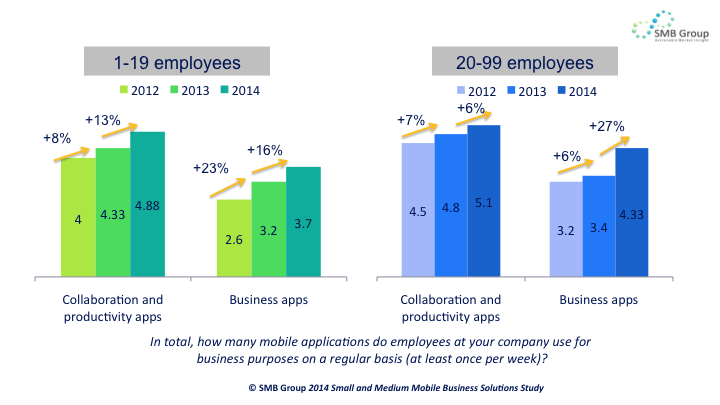
Since upwards of 80% of very small and small businesses already use basic collaboration and productivity tools such as email, calendar and contacts, growth is tapering somewhat in this area. However, some mobile collaboration and productivity apps are poised for strong gains next year, with 20%-plus of small business respondents planning to deploy mobile conferencing, document management, find-me-follow-me presence, personal assistant and/or document editing and creation apps within the next 12 months.
Mobile business apps have made bigger gains over the past three years, particularly among businesses with 20-99 employees, where the number of mobile business apps used regularly jumped 27% over the past year. We expect this trend to continue, as respondent’s plans to add new mobile business apps in the next 12 months were strong across the board. Mobile apps for time management and capture lead the way, with 25% of both very small and small businesses planning to add this capability; followed by mobile marketing and advertising (24%); business analytics (23%); and financial management/payment processing (23%).
Furthermore, 67% of very small and 73% of small businesses believe that mobile apps will replace some of their current business applications, further underscoring that mobile apps are becoming core to the business (Figure 4).
Figure 4: Mobile Apps Increasingly Likely to Complement/Displace Traditional Business Apps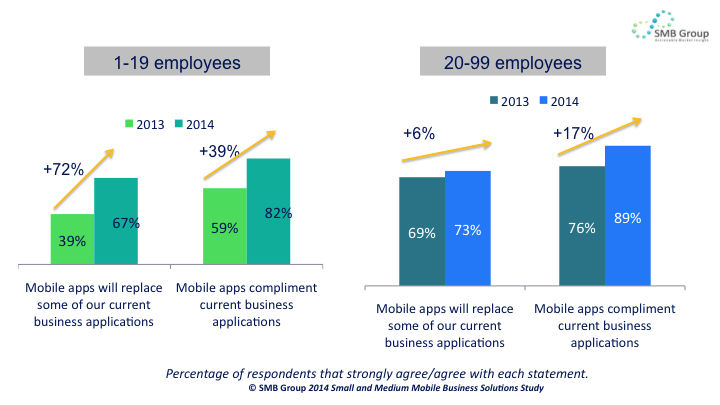
BYOD Support Still Gaining
Employees increasingly want to use their own devices to access corporate data. This is part of a growing trend dubbed Bring Your Own Device (BYOD). In the BYOD model, employees can use the device of their choice for work. BYOD has both pros and cons. Most people think it helps improve employee productivity, and some think it can lower costs. However, most also agree that BYOD devices are more difficult to manage and secure than company owned devices.
Despite these tradeoffs, small business support for bring-your-own-device (BYOD) programs for employees also continues to enjoy strong growth (Figure 5). Top drivers for the 60% of small businesses that currently support BYOD support include employee familiarity/preference for their own device (71%); saving money (63%); and meeting employee expectations/demands (42%). Roughly one-quarter of these businesses pay for all smartphone device and service expenses. In contrast, 20% cover smartphone service plan costs only; 18% cover business use expenses only, and 20% provide employees with fixed monthly stipends. Interestingly, 18% expect employees to use their own mobile device for work but do not cover any BYOD expenses.
Figure 5: Growth In Small Business BYOD Support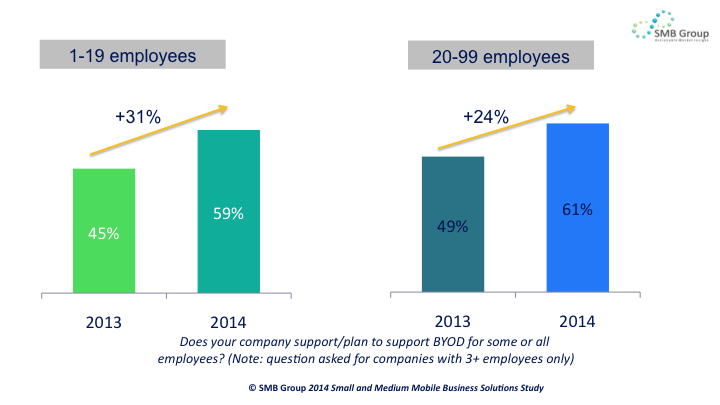
But BYOD challenges hinder wider adoption. 40% of small businesses don’t support BYOD due to security concerns (56%); difficult to manage (54%); and because reimbursing employees for BYOD is too time consuming/complex (38%). These businesses are not likely to add BYOD support until it is easier to partition, secure, bill and manage work-related versus personal mobile use and expenses.
Small Businesses Slower to Add Mobile Management Capabilities
In fact, small business adoption of bright and shiny mobile devices and apps has quickly outpaced their embrace of mobile management solutions in general. As shown on Figure 6, only 43% of businesses with 20-99 employees are using a mobile device management solution, while just 33% use a solution to manage and secure mobile apps.
Figure 6: Small Business (20-99 employees) Adoption of Mobile Management Solutions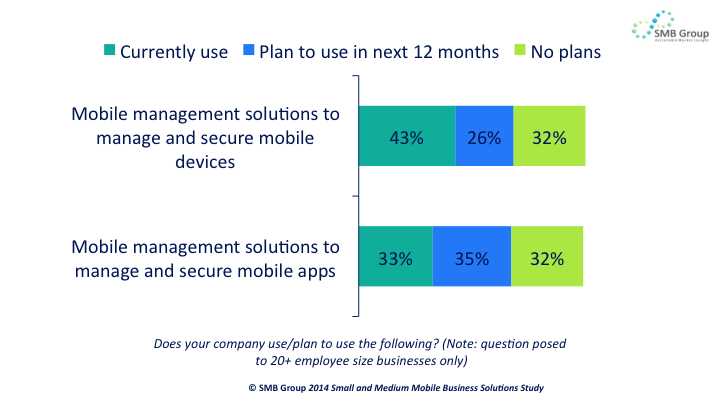
In addition, while small business spending on mobile devices, service plans and apps as a percentage of total mobile spending has risen from 2013 to 2014, spending on mobile management, consulting and security has declined somewhat from 2013.
But it does not appear that cost is what’s holding small businesses back. Just 16% of respondents said that they didn’t’ use a mobile management solution because they are too expensive. Instead, the biggest obstacles are they don’t think they need it (51%); they don’t know which solution is right for their company (22%) and they don’t have the resources to deploy it (22%).
Perspective
Small businesses are clearly swept up in the mobile tsunami, and mobile solutions are becoming essential to small business success. However, small business adoption of mobile devices, apps and services is rapidly outpacing their ability to secure and manage mobile assets.
Without appropriate mobile device, application and data management policies and solutions in place, small businesses risk putting their corporate financial and brand security at ever-higher risk. In addition, as reliance on mobile solutions rises without adequate attention to management, many small businesses will find manual attempts to track and manage mobile use increasingly time-consuming and frustrating.
Study findings strongly suggest that while small businesses have quickly grasped how mobile can help their businesses, they are still struggling to understand the why, what, and how of mobile management. Vendors will need to dramatically ramp up education, guidance and consulting initiative and services to help more small businesses understand and take action in this area.
This is the first post in a two-part series sponsored by Dell that discusses how small businesses are using mobile technologies in their businesses.

